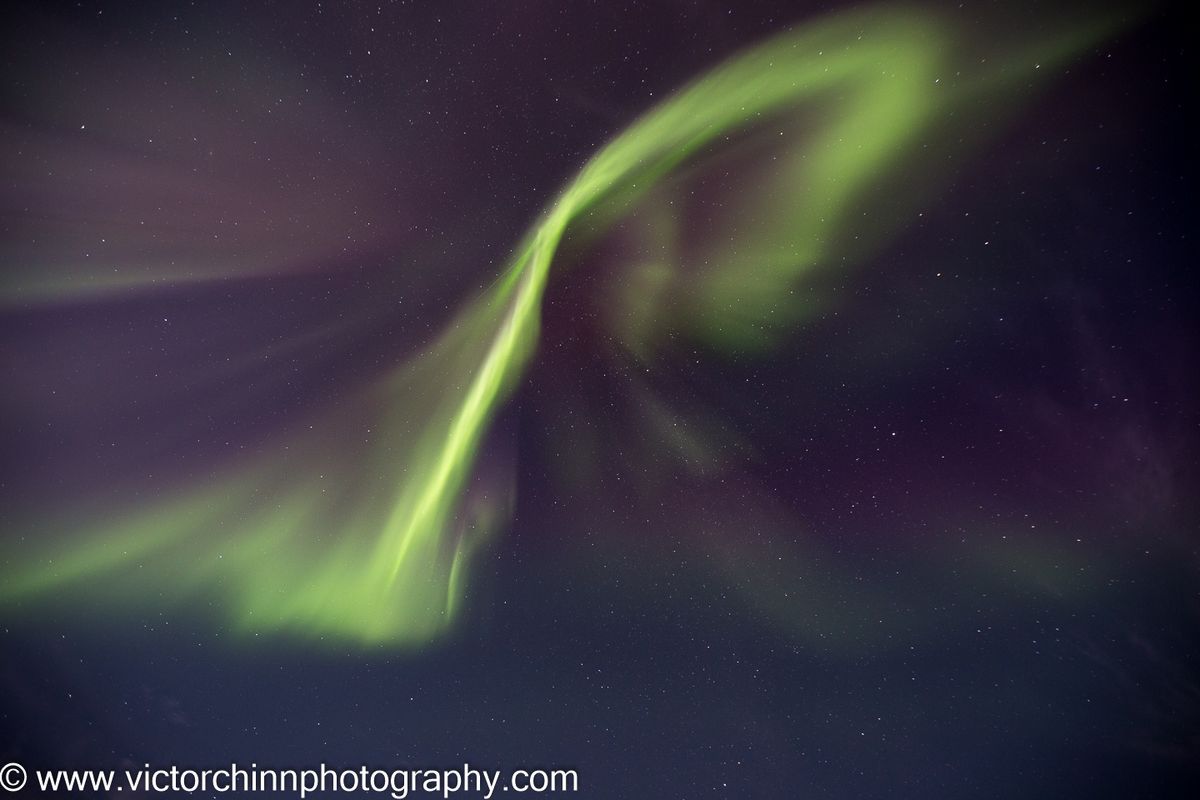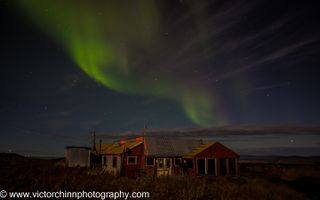Spectacular Auroras Light Up Alaska Skies (Photos)

The superheated particles launched from the sun after two back-to-black solar flares erupted this week have created dazzling light shows for skywatchers.
Filling the skies near Cleary Summit in Fairbanks, Alaska, with their eerie green and purple-pink glow, the northern lights made for quite a sight. And Victor Chinn, a resident of Bellevue, Washington, was ready to capture the glory with his Canon 6D on Friday (Sept. 12). In fact, knowing that the solar flares and the resulting geomagnetic storms would likely supercharge the aurora in northern regions, he boarded a flight to Anchorage, Alaska.
Such colorful auroras occur when a stream of superheated particles interacts with Earth's magnetic field, and in doing so, releases quick-moving electrons from this magnetosphere region. The charged particles then bump up against atoms of oxygen and nitrogen. Result? The oxygen and nitrogen release their added energy (from the electrons) in the form of small bursts of colored light. [Aurora Photos: Northern Lights Dazzle in Night-Sky Images]
"I have been wanting to view the aurora borealis live since my childhood, but never got the opportunity (even after trying one time to see them in Iceland)," Chinn told Live Science in an email. "I cashed in some Alaska Airline frequent flier miles and got myself up here yesterday to Fairbanks, where I rented a car and drove up to near Cleary Summit for this photo."
A minor solar flare erupted from the sun on Monday (Sept. 8), followed by an intense X1.6-class solar flare on Wednesday at 1:46 p.m. ET, both originating from the sunspot AR2158, which is more than 10 times the size of Earth. The resulting coronal mass ejections, or streams of charged particles, zipped toward Earth, with the stronger flare sending these particles rocketing through space at millions of miles per hour. This stronger, second wave of superheated particles was expected to reach Earth yesterday (Sept. 12) and today (Sept. 13), though scientists don't expect any major disruptions on Earth.

Scientists did expect the solar flares would result in supercharged northern light shows, and even astronauts aboard the International Space Station had their eyes (and instruments) on the ready.
"We do expect these storm levels to cause significant auroral displays across much of the northern U.S. on Friday night," Thomas Berger, director of the Space Weather Prediction Center (SWPC) in Boulder, Colorado, told reporters on Thursday, as reported by Space.com (sister site to Live Science). "With clear skies currently forecast for much of these regions, this could be a good opportunity for auroral sightings."
Sign up for the Live Science daily newsletter now
Get the world’s most fascinating discoveries delivered straight to your inbox.
While photographing the resulting northern lights, Chinn got another surprise. "While waiting in the dark for the right moment to photograph the northern lights, however, I did receive a, curious for him but a little frightening for me, visit from a fox who gave my backpack a really good sniff and a long stare for me," Chinn said.
Strong solar storms are currently bombarding Earth due to Wednesday's coronal mass ejection, according to a statement by the SWPC today. "Earth remains under the influence of this CME and will continue to for the near term."
Follow Jeanna Bryner on Twitter and Google+. Follow us @livescience, Facebook & Google+. Original article on LiveScience.
Jeanna Bryner is managing editor of Scientific American. Previously she was editor in chief of Live Science and, prior to that, an editor at Scholastic's Science World magazine. Bryner has an English degree from Salisbury University, a master's degree in biogeochemistry and environmental sciences from the University of Maryland and a graduate science journalism degree from New York University. She has worked as a biologist in Florida, where she monitored wetlands and did field surveys for endangered species, including the gorgeous Florida Scrub Jay. She also received an ocean sciences journalism fellowship from the Woods Hole Oceanographic Institution. She is a firm believer that science is for everyone and that just about everything can be viewed through the lens of science.











